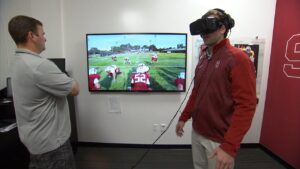
Virtual reality is around us. It is no longer a supernatural headpiece that only the rich and famous get to wear. It does not belong to sci-fi writers. Their adventurous characters. It has blossomed into our everyday lives; into our homes and businesses. VR has gradually made the shift from the entertainment industry, where it is still being used, to the enterprise industry. Many small businesses, tech giants, and big corporations are implementing this type of technology into the working environment. VR startups have come alive with possibilities only limited to the human imagination.
For the past six years, virtual reality has been two years away from mainstream adoption. That might seem like a short amount of time but in those six years, businesses were busy with many transactions and were everything but dormant. Huge companies have made huge VR bets only to walk away later, hundreds of VR startups have faded or flared up, and its investments have slowed down significantly. This one type of technology has the power to change the course of financial and economic history for the rest of our lives.
There are many areas of opportunity that businesses want to sink their claws into but not many get it right as often as they would like. One of the few major areas of opportunity that has remained and stood the test of time is building attractive VR solutions for large enterprises to train their employees remotely. This area has largely been dominated by VR workplace training startup, Strivr. The company just locked down new funding. This brought their total amount raised to million. Not only is this an impressive amount for a startup but it is also notable that the money was raised in such a competitive market.
The VR training setup closed a million Series B round that was led by Canadian Firm, Gregorian Partners, a company that hasn’t been very active in the VR/AR space in the last few years. Derek Belch, the CEO, stated that the company had to pitch a few dozen firms during this raise, and the feedback was overwhelmingly positive. However, a positive response is not without criticism. Belch explained that it is no secret that VR has been slower to adopt. It has been tough to anticipate, even though there is so much room for potential.

It is very common for VR/AR startups to raise money so that their business can be successful. This was the case in 2016 when Strivr closed its seed round. In 2020, however, the situation changed. The market is not as abundant as it used to be with the initial boom of virtual reality technologies. This is because quite a few years have gone by. It was filled with missed estimates and a brutal showcase of shutdowns. As with any new industry, people need to buy into an idea before it can be sold to them.
VR startups have struggled in the past few months to get their businesses off the ground due to not having access to proper funding from other companies or institutions. Despite the odds, there has still been movement among enterprise offerings. Earlier this month, Talespin, a competing VR training platform, cinched million funding. Similarly, the AR/VR teleconferencing app, Spatial, locked down million. In December last year, HaptX, a company that makes high-end VR gloves for enterprise use cases, managed to get million in funding. These are by no means small amounts that have been invested into these VR startup companies.
It has always been difficult for VR enterprise startups to land post-Series A funding because here players often find themselves in a position where they are judged against their VR peers and not to a Salesforce, Box, or Atlassian. Belch said that nobody can get beyond a pilot program and that investors want to know how real the market is. He also mentioned that it is important for investors to know exactly who their target market is before making any serious commitments. While these are all valid concerns, it has still made it challenging for VR startups to get any form of recognition.
Strivr came to life from Belch’s 2014 research at Stanford. It was initially a VR application designed to help football players train off the field. Belch himself had previously played football. He was the kicker for Stanford’s football team. His co-founder, Jeremy Bailenson, led the school’s Virtual Human Interaction Lab. This lab was a leading research center that gained attraction when Mark Zuckerberg, CEO of Facebook, visited when doing diligence on Facebook’s virtual reality system, Oculus. Together they could use their skills and expertise to bring Strivr to life. They have worked hard to develop it into the company it is today.
As time went on, virtual reality gear was gaining popularity, and investment in this environment grew more serious. Strivr soon moved from sports training to workplace training. They started pitching their solution as a better way for companies to hand top-down instruction to employees. Their software offers a combination of interactive 360-degree videos and computer-generated scenarios that require a bit more participation from a trainee. It has turned into a versatile tool that can boost company morale and make for effective training without running the risk of the trainee making any serious real-time mistakes.
Many VR companies have pushed to integrate their products and services with phone or tablet-based experience. Belch stood strong against this idea. He says that he has pushed back on customer requests to move away from the headset-only experiences towards phone-based 360-degree videos. He stated that that type of product is not their disruption. He believes them to be gimmicky and a cheap way to build a brand. He mentioned that he prefers to deliver quality experiences along with professional services to his clients. In this way, he ensures that his brand is always reliable & credible, no matter what situation they might experience.
March 31, 2020
























